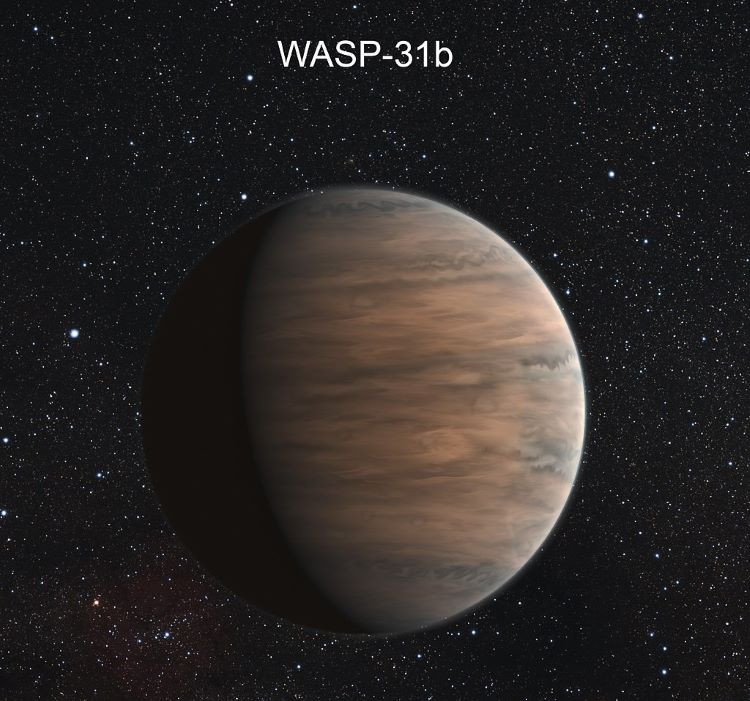A recent study published in The Astrophysical Journal Letters examines a rare alloy molecule known as chromium hydride (CrH) and its first-time confirmation on an exoplanet, in this case, WASP-31 b. Traditionally, CrH is only found in large quantities between 1,200 to 2,000 degrees Kelvin (926.85 to 1,726.85 degrees Celsius/1700 to 3,140 degrees Fahrenheit) and used to ascertain the temperature of cool stars and brown dwarfs. Therefore, astronomers like Dr. Laura Flagg in the Department of Astronomy and Carl Sagan Institute at Cornell University refer to CrH as a “thermometer for stars”.
For the study, the researchers analyzed the transmission spectrum of WASP-31 b using a combination of data from March 2022 and archival data from 2017 to ascertain that WASP-31 b possessed CrH within its atmosphere. The reason why the 2017 data was included in this current study was because it was initially not used to identify metal hydrides.
“Part of our data for this paper was old data that was on the very edge of the data set. You wouldn’t have looked for it,” said Dr. Flagg, who is lead author of the study.
For context within our own solar system, CrH has only been identified within sunspots on our Sun, with Dr. Flagg noting that the Sun is too hot (surface temperatures of approximately 6,000 degrees Kelvin (5,726.85 degrees Celsius)), and all remaining objects within the solar system are below 1,200 degrees Kelvin.
Discovered in 2010 using transit photometry by the WASP project, WASP-31 b is located approximately 1,252 light-years from Earth with a radius just over 1.5 times larger than Jupiter and a mass just under half of it, as well. Its orbital period around its F5V main-sequence star is 3.4 days, making WASP-31 b a “hot Jupiter”. For context, our Sun is designated as a G-type main-sequence star, with F-type main-sequence stars being slightly larger along with exhibiting slightly higher surface temperatures (~6,300 degrees Kelvin). That WASP-31 b is as cool as it is despite its parent star being hotter than our own Sun makes this finding all the more intriguing.

Dr. Flagg specializes in using high-resolution spectroscopy to identify and study the atmospheres of exoplanets, while also studying the formation and evolution of exoplanets orbiting young stars, as well. Spectroscopy involves using light to determine what elements might be present based on their color within the electromagnetic spectrum. For astronomy, this means using spectroscopy to study exoplanet atmospheres by measuring the parent star’s light passing through it. In the case of WASP-31 b, spectroscopy was used to measure the light from its parent star to identify CrH within WASP-31 b’s atmosphere.
“High spectral resolution means we have very precise wavelength information,” said Dr. Flagg. “We can get thousands of different lines. We combine them using various statistical methods, using a template – an approximate idea of what the spectrum looks like – and we compare it to the data, and we match it up. If it matches well, there’s a signal. We try all the different templates, and in this case the chromium hydride template produced a signal.” Dr. Flagg notes that sensitive instruments and telescopes are required to identify CrH due to its rarity, even at the current temperature.
While the research team states this is the first confirmed detection of CrH on an exoplanet, this research builds on a 2021 study which reported the first evidence for CrH in the atmosphere of WASP-31 b, but those researchers stopped short of calling it a confirmed finding based on their data at the time.
With this new confirmation of CrH, the team notes this could open doors for using high-resolution observations for studying exoplanet atmospheres, going as far as saying WASP-31 b will not be the last exoplanet where the presence of CrH will be confirmed.
How many more exoplanets will astronomers confirm the presence of CrH throughout the cosmos, and what can CrH teach us about exoplanet atmospheres in the coming years and decades? Only time will tell, and this is why we science!
As always, keep doing science & keep looking up!
